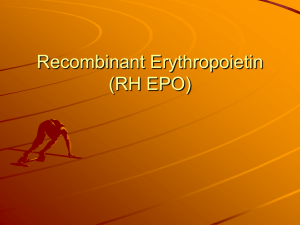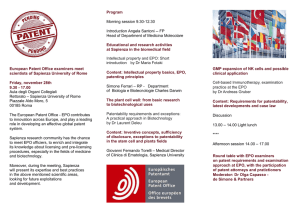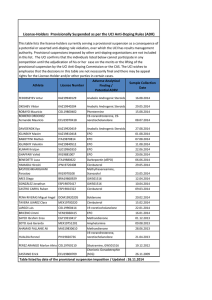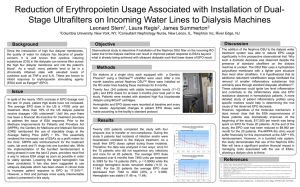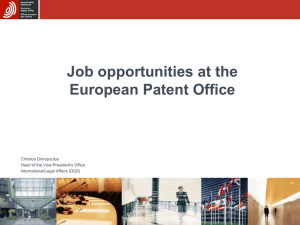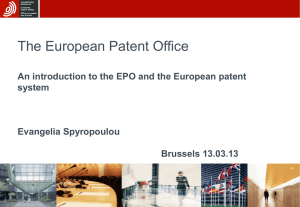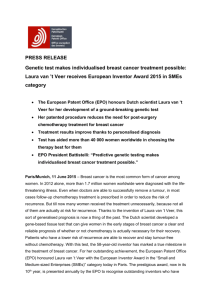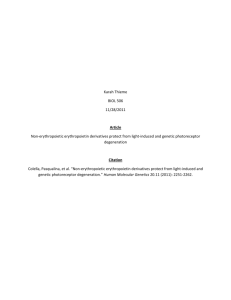Case Study - Association of American Colleges
advertisement
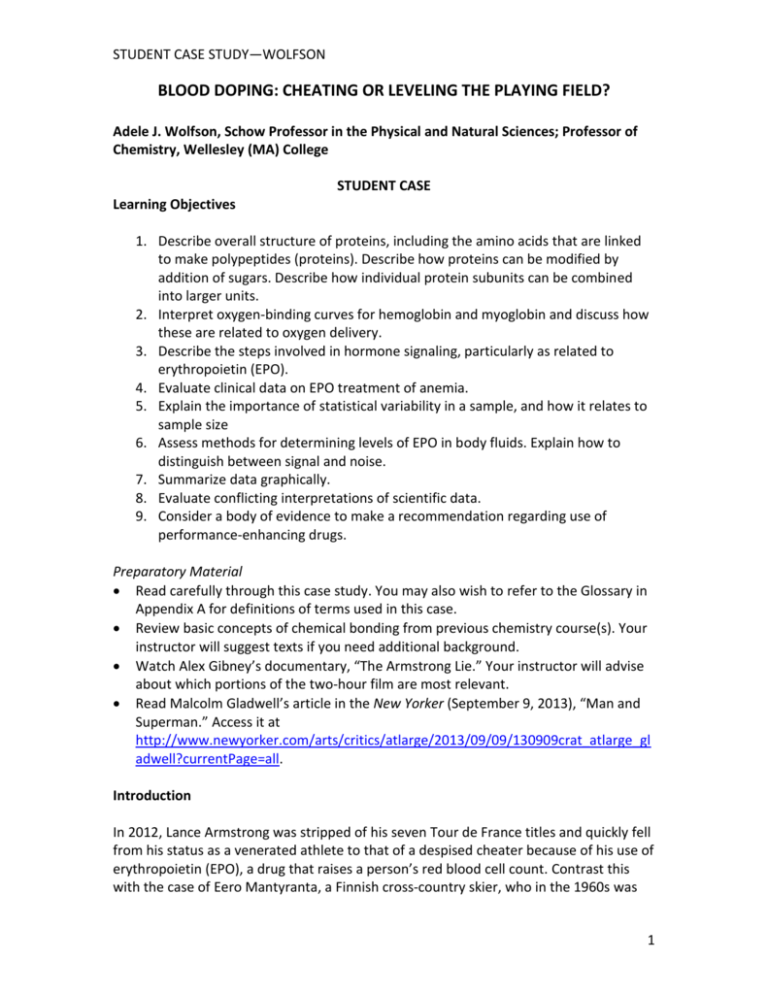
STUDENT CASE STUDY—WOLFSON BLOOD DOPING: CHEATING OR LEVELING THE PLAYING FIELD? Adele J. Wolfson, Schow Professor in the Physical and Natural Sciences; Professor of Chemistry, Wellesley (MA) College STUDENT CASE Learning Objectives 1. Describe overall structure of proteins, including the amino acids that are linked to make polypeptides (proteins). Describe how proteins can be modified by addition of sugars. Describe how individual protein subunits can be combined into larger units. 2. Interpret oxygen-binding curves for hemoglobin and myoglobin and discuss how these are related to oxygen delivery. 3. Describe the steps involved in hormone signaling, particularly as related to erythropoietin (EPO). 4. Evaluate clinical data on EPO treatment of anemia. 5. Explain the importance of statistical variability in a sample, and how it relates to sample size 6. Assess methods for determining levels of EPO in body fluids. Explain how to distinguish between signal and noise. 7. Summarize data graphically. 8. Evaluate conflicting interpretations of scientific data. 9. Consider a body of evidence to make a recommendation regarding use of performance-enhancing drugs. Preparatory Material Read carefully through this case study. You may also wish to refer to the Glossary in Appendix A for definitions of terms used in this case. Review basic concepts of chemical bonding from previous chemistry course(s). Your instructor will suggest texts if you need additional background. Watch Alex Gibney’s documentary, “The Armstrong Lie.” Your instructor will advise about which portions of the two-hour film are most relevant. Read Malcolm Gladwell’s article in the New Yorker (September 9, 2013), “Man and Superman.” Access it at http://www.newyorker.com/arts/critics/atlarge/2013/09/09/130909crat_atlarge_gl adwell?currentPage=all. Introduction In 2012, Lance Armstrong was stripped of his seven Tour de France titles and quickly fell from his status as a venerated athlete to that of a despised cheater because of his use of erythropoietin (EPO), a drug that raises a person’s red blood cell count. Contrast this with the case of Eero Mantyranta, a Finnish cross-country skier, who in the 1960s was 1 STUDENT CASE STUDY—WOLFSON honored as an Olympic champion, winning a total of seven medals. Mantyranta’s complexion was notably ruddy because he had a naturally high number of red blood cells in his circulation. What is the difference (physiologically and ethically) between being born with extra red blood cells and taking a drug that increases your count? This case examines the data on EPO: how is it used medically, and how effective is it? How is EPO detected in the body, and why is it so difficult to tell if an athlete has taken the drug? Along the way you will be introduced to the properties of the molecule EPO itself and how it acts, as well as to hemoglobin, the oxygen-transport protein of blood, which makes up 95 percent of protein in red blood cells. At the end of the case you will return to the question of the legitimacy of using naturally occurring substances to enhance performance. Exploring the Question 1 Proteins The two important molecule “players” in this case are hemoglobin (Hb) and erythropoietin (EPO). Hb is the oxygen-carrier in blood; it accounts for most of the content of red blood cells. EPO is a hormone that signals bone marrow to make more red blood cells. Both Hb and EPO are proteins, one of the major classes of macromolecules in biological systems. As the name macromolecule implies, these are very large molecules with molecular weights ranging from thousands to hundreds of thousands. The synthesis of such large molecules would be a real problem for the cell if they were put together as a chemist might do it in the lab, bit by bit. Instead, for the most part, the macromolecules are put together from subunits, or monomers. So, the macromolecules are polymers made from monomers, of which there are a limited number, and these monomers are strung together by the same reaction over and over again. Proteins are biological macromolecules that are made up of one or more polypeptide, each of which is a chain of amino acids. 1 Unless otherwise noted, figures are from Ahern, K. and I. Rajagopal. Version 2.0 Biochemistry Free and Easy, 2012, 2013, available for download at: http://biochem.science.oregonstate.edu/biochemistry-freeand-easy. Some questions/exercises are adapted from Loertscher, L., and V. Minderhout. 2010. Foundations of Biochemistry. Lisle, IL: Pacific Crest. For biochemistry topics, any textbook including the Ahern and Rajagopal reference cited above, is appropriate. I also recommend, Biochemistry: A Short Course by Tymoczo, J. L., J. M. Berg, and L. Stryer. 2013. New York: W. H. Freeman. 2 STUDENT CASE STUDY—WOLFSON The monomers for proteins are amino acids. All amino acids have the overall structure shown in Figure 1: (http://biochemportal.wordpress.com/2013/03/17/amino-acids-and-meth/) Figure 1. Generalized Structure of an Amino Acid. There are 20 amino acids that occur naturally in proteins. The letter R in the general structure refers to one of the 20 chemical groups that confer particular physical or chemical properties (charge, interactions with water, etc.) to each. In a protein, amino acids are connected by (strong) covalent bonds called peptide bonds (Figure 2): Figure 2. Generalized Structure of a Peptide. Based on its unique amino acid sequence, each polypeptide folds into the most stable three-dimensional shape, and it is this shape that determines the specific function (activity) of the protein. The three-dimensional structure is stabilized by interactions called non-covalent because they are weaker than covalent ones, but they are still very important in the aggregate. Some proteins have more than one chain (subunit), and these come together in specific ways that are also stabilized by non-covalent interactions. Hb is an example of one such protein. It is composed of four subunits, two of each of two kinds. Proteins with multiple subunits can be regulated in complex ways. More details of this regulation are discussed below. 3 STUDENT CASE STUDY—WOLFSON Additionally, some proteins have additional “decoration” added to them after they are synthesized. EPO is an example of such a protein. It has sugar molecules added onto some of its amino acids. Sugars account for approximately 40 percent of its weight. As we will see in later sections, the pattern of these sugars can tell us about the origins of the EPO. Many proteins also have non-amino acid, or prosthetic groups. One of these is heme, discussed on page 5, below. Hemoglobin Examine the binding curves below (Figure 3) for hemoglobin and the related protein myoglobin (Mb). The units for pressure are torr, sometimes expressed as “mm Hg.” Typical oxygen pressure in the lungs is ~100 torr and in body tissues is ~40 torr. Note that “percent saturated with oxygen” can also be described as “percent of subunits that have oxygen bound.” Myoglobin can be considered an oxygen-storage protein in muscle tissue. Recall that hemoglobin circulates in the blood. Answer the questions that follow: Figure 3. Oxygen-binding Curves for Myoglobin and Hemoglobin. Questions 1. What is plotted on the x-axis? On the y-axis? 2. How does the percent saturation change with increasing oxygen concentration (O2 pressure) for both Mb and Hb? 4 STUDENT CASE STUDY—WOLFSON 3. What does this graph tell you about how hemoglobin effectively delivers oxygen from lungs to tissue? 4. We define p50 as the pressure (concentration) of oxygen when Hb or Mb is halfsaturated. Is the p50 for Mb greater than or less than that for Hb? 5. How is p50 useful for quantification of Hb or Mb binding of oxygen? 6. On the graph, draw a new curve for hemoglobin that is shifted to the right. How does the value of p50 for the new curve compare to the original p50? How does the oxygen-binding affinity of the hemoglobin represented in the new curve compare to that of the original? What would that mean for delivery to the tissue? 7. How would shifting the curve to the left affect p50? In what part of the body would it be useful for this to occur? The shape of the oxygen-binding curve of Hb is typical of cooperative binding. That is, binding of one molecule of O2 to Hb makes it easier to bind the next molecule of O2. Cooperativity almost always requires a protein with multiple subunits. The interactions among subunits, along with binding of some small regulatory molecules, lead to the cooperative effects. This behavior allows Hb to be fully loaded with O2 in the lungs, but to unload O2 to Mb in the tissues. Mb, with only a single subunit, does not display cooperativity. The actual binding site for oxygen in Hb (and Mb) is the iron ion in the center of a molecule called heme; Figures 4a and 4b display this structure: Figures 4a and 4b. Structure of the Heme Prosthetic Group: (a) Chemical Structure of the Isolated Group; (b) Shorthand Version of the Ring Structure with Coordinated Amino Acid Side chains in Hemoglobin, with Oxygen Bound. 5 STUDENT CASE STUDY—WOLFSON Because iron is essential for synthesis of Hb, the increase in levels of Hb and red blood cells is accompanied by a decrease in stored iron from the storage protein ferritin, particularly in bone marrow, liver, and spleen. There is one heme for each of the subunits in Hb (i.e., four total). When oxygen binds to the iron in heme, it causes major changes in the overall structure of the protein, so much so that crystals of Hb will crack if oxygen is diffused in. The changes in structure on binding are responsible for much of the behavior of Hb related to binding oxygen in the lung and releasing it to the organs as needed. Erythropoietin EPO is produced in the kidney in response to low oxygen levels and acts on bone marrow cells to produce red blood cells (Figure 5). http://classes.midlandstech.com/carterp/Courses/bio211/cha/Slide7.JPG Figure 5. Physiological Role of EPO. EPO is an example of a protein that signals cells to “turn on” specific genes and produce more of a particular product, usually a protein. Figure 6 presents a general scheme for such signaling molecules. As the diagram shows, the hormone or growth factor does not enter the cell but rather attaches to a specific protein embedded in the outer membrane, called a receptor. Binding of the hormone or growth factor generates signals inside the cell that result in activation of one or more genes in the nucleus of the cell. Each gene is a specific DNA region that encodes the information for one polypeptide. When a gene is activated, thousands of copies of this genetic information are synthesized (“transcribed”) and transported to the cytoplasm of the cell, where they provide instructions for the synthesis of the polypeptide encoded by the gene. 6 STUDENT CASE STUDY—WOLFSON http://www.hartnell.edu/tutorials/biology/signaltransduction.html Figure 6. Generalized Scheme for Binding of a Signaling Molecule to the Outer Membrane, Triggering Events in the Cells via Second Messengers (“Relay Molecules”). More details for EPO are shown below in Figure 7. http://www.ijem.in/articles/2012/16/2/images/IndianJEndocrMetab_2012_16_2_220_ 93739_f3.jpg Figure 7. Specific Signaling Used by EPO. JAK = Janus kinase and STAT = Signal Transducer and Activator of Transcription. Note that there are many STATs. 7 STUDENT CASE STUDY—WOLFSON Questions Use Figure 5 to help answer these questions about Figures 6 and 7. 1. Using the nomenclature from the Figure 6, above, what in Figure 7 might be considered the “signaling molecule?” the “relay molecules”? 2. What do you expect is the target cell? 3. Which gene(s) do you expect will be “turned on” in these target cells? As described above, EPO is a glycoprotein. The figure below shows that sugars are attached to the protein. This occurs through bonds to specific amino acids making up the protein. In the figure, the "ribbon" represents the protein portion, while the other shapes identified in the key are different types of sugars (carbohydrates). Wu, B. , J. Chen, J. D. Warren, G. Chen, Z. Hua, and S. J. Danishefsky. 2006. “Building Complex Glycoproteins: Development of a Cysteine-free Native Chemical Ligation Protocol,” Agnew. Chem. Int. Ed. 45: 4116–25. Copyright © 2006 WILEY-VCH Verlag GmbH and Co. KGaA, Weinheim. Figure 8. EPO as Naturally Occurring, with Sugars Attached. The sugars do not seem to affect the way that EPO attaches to bone marrow cells to signal production of Hb and red blood cells, but they do influence how long EPO can circulate in the bloodstream. 8 STUDENT CASE STUDY—WOLFSON Interpreting Hb and EPO Levels in Groups and Individuals Naturally occurring levels: The amount of hemoglobin in a person’s body is reported in g/dL (grams per deciliter, or 100 mL, of blood). The normal ranges are: Women: 12.3–15.3 (according to some sources, 12–16) (mean 13.8) g/dL Men: 14.0–17.5 (according to some sources, 13.5–18) (mean 15.7) g/dL (http://emedicine.medscape.com/article/2085614-overview, original reference: Vajpaye et al. 2011; Dailey 2001) Questions 1. Graph the values of hemoglobin for men and women in whatever format you think will convey the information. 2. How would you describe in words the differences between men and women? The differences within each of those groups? 3. If you were given a value for hemoglobin in a given sample, would that allow you to determine whether that sample came from a male or female? Why or why not? You may also see reports of the hematocrit, the volume taken up by red blood cells compared to the total blood volume. Now let’s look at EPO and hematocrit distributions in people with diagnosed illnesses, compared to normal values. Consider the graph below (Figure 9) and answer the questions that follow: Other Bunn, H. F. 2013. Cold Spring Harbor Perspectives in Medicine, 3(3):a011619. © 2013 Cold Spring Harbor Laboratory Press. 9 STUDENT CASE STUDY—WOLFSON Figure 9. Plasma EPO Levels (milliunits/mL) in Patients with Different Types and Degrees of Anemia and other Conditions. Questions 1. What is on the x-axis? On the y-axis? 2. Note that EPO levels are plotted on a logarithmic scale. What does this mean? Why would a researcher choose to use this scale? 3. Give the range for normal levels of EPO and for normal hematocrit readings. 4. Give the range for levels of EPO and for hematocrit readings for the condition identified here as “uremia.” 5. Give the range for levels of EPO and for hematocrit readings for the condition identified here as “PCV.” 6. If you were given a value for hematocrit for a particular patient, could you predict EPO levels in that patient? Figure 10 takes a closer look at just two groups: those with anemia and normal blood donors. From New England Journal of Medicine, Erslev, A. J. “Erythropoietin,” 324(10): 1340. Copyright © 1991, Massachusetts Medical Society. Reprinted with permission from Massachusetts Medical Society. 10 STUDENT CASE STUDY—WOLFSON Figure 10. Plasma EPO Levels in Normal Blood Donors and Patients with Anemia. Triangles represent normal donors, squares those of various anemias. The dashed line represents the limit of detection of the assay. Questions 1. Compare Figure 10 with Figure 9, above. What are the differences in units? In range? 2. What relationship between plasma EPO and hematocrit emerges more clearly from this figure than from Figure 9? 3. What is meant by the “limit of detection”? If the researchers obtained a value of plasma EPO of 2 U/liter, how confident could you be that this number is larger than 1 U/liter? If the researchers told you that EPO was absent from the sample, could you say with confidence that there was no EPO present? Sometimes, distinguishing between “nothing” and “some particular value” is referred to as the difference between “signal and noise.” Is this a good term for the phenomenon? What is the “signal” and what is the “noise?” Therapeutic use: EPO has been used for at least 30 years to increase Hb and red blood cell production in patients with anemia. Consider these data (Table 1) from one of the earliest reports of use of EPO in anemia: From J. W. Eschbach, J. C. Egrie, M. E. Downing, J. K. Browne, and J. W. Adamson. 1987. “Correction of the Anemia of End-stage Renal Disease with Recombinant Human Erythropoietin,” New England Journal of Medicine, 316: 75. Copyright ©1987 11 STUDENT CASE STUDY—WOLFSON Massachusetts Medical Society. Reprinted with permission from Massachusetts Medical Society. Questions 1. What is meant by “mean ± S.D.”? What does the “±” value tell you about precision of measurements? 2. The means in Table 1 are estimates based on the hematocrits measured for a limited number of patients. How would increasing the number of patients affect your certainty about how good these estimates are? 3. What appears to be the relationship between dose of EPO and hematocrit? 4. Why was it important to establish a base line before administering the therapeutic doses? The patients entered into this study met the following criteria, among others: - They were in a particular age range. - They had hematocrit below a certain value. - They had not lost blood due to any other reason than their anemia. - They had no other diseases that might mask the effects of the treatment. Questions 5. Think about what question the investigators actually wanted to answer. What would the ideal (best case) data set look like to answer that question? 6. Given that the ideal experiment can never be done, what data set could they get that would allow them to estimate the answer? 7. Is their set of patients closer to “ideal” or to “data they could get”? Use of EPO in sports: EPO has been banned from the Olympics since 1990. In order to determine whether or not athletes were using EPO illegally, officials needed methods to measure or otherwise detect its presence. One way to measure EPO is to look for it in urine or blood. Natural and artificial EPO could be distinguished in the early days of its production because the sugars attached to the protein (see Figure 8) were slightly different when produced in the lab (in nonhuman cells) compared to those attached in the body. Some of these sugars have charges (positive or negative) associated with them, so that the overall protein moves differently in an electric field depending on the nature and number of these sugars2. The amount of EPO protein, natural or artificial, can then be quantified. Figure 11 shows an example of what the samples look like when subjected to the method: 2 You can read more about this technique (electrophoresis) in Tymoczo, Berg, and Stryer (2013), 72–74. 12 STUDENT CASE STUDY—WOLFSON Reprinted by permission from Macmillan Publishers, Ltd.: Lasne, F., and J. de Ceaurriz. 2000. “Recombinant Erythropoietin in Urine,” Nature, 405(6787): 635. Copyright 2000. http://www.nature.com/nature/index.html Figure 11. Patterns of Natural and Artificial EPO Obtained from Urine (a) Natural Human EPO; (b) Recombinant (Artificial) EPO Source 1; (c) Recombinant (Artificial) EPO Source 2; (d) Urine from Control Subject; (e) and (f): Urine from Two Patients Treated with Recombinant EPO; (g) and (h): Urine from Two Cyclists in the Tour de France. Questions 1. Why is it important to include standards alongside the samples collected from athletes? 2. Can you see a clear distinction between the natural and artificial standards? 3. Can you see a clear distinction between individuals treated with artificial EPO and those who have not been treated? Which area(s) of the gel would you want to examine in order to make that decision? 4. Does your answer to (3) allow you to draw a firm conclusion about whether or not the cyclists have taken artificial EPO? Unfortunately, this method is very time consuming, and the amount of EPO is undetectable in 3–7 days after treatment. Furthermore, more recent versions of recombinant EPO are indistinguishable by this test from the natural form. Another method to detect artificial EPO use is to look for its physiological effects on hematocrit, hemoglobin concentration, or amount of protein that transfers iron. Because of doping scandals in sports, some associations have introduced an upper limit for acceptable Hb concentrations in blood. Figure 12 comes from Nordic ski competitions in the 1980s and 1990s: 13 STUDENT CASE STUDY—WOLFSON From Videman et al. 2008. “Changes in Hemoglobin Values in Elite Cross-country Skiers from 1987 to 1999.” Scandinavian Journal of Medicine and Science in Sports, 10(2): 98– 102. Copyright ©2008 John Wiley and Sons. Figure 12. Mean Values (bars), Standard Deviations (solid vertical line), and Maximum Individual (dotted vertical line) for Hemoglobin Values from Cross-country Skiers. The lower horizontal line represents the population mean and the upper horizontal line the means for several ski nations. Questions 1. What is your interpretation of the “mean” and “standard deviation”? How do they relate to the ranges and separation of values you have seen earlier? 14 STUDENT CASE STUDY—WOLFSON 2. Select one year prior to the “FIS Hb rule” introduction. Report the mean Hb level in women that year, the standard deviation of that mean, and the maximum value for any individual skier. Do the same for men in that same year. 3. How do the values for these female and male skiers compare to the population means? 4. Could any of the skiers in the year you analyzed show a Hb value below that of average people in the population sample? 5. If the FIS Hb rule eliminated from competition men with Hb levels greater than 170 g/L and women with levels greater than 160 g/L, would that exclude any of the athletes? Any of the non-athletes who wanted to compete? 6. What problems do you see in a specific Hb cutoff for sports events? (Hint: go back to data on normal ranges. You will need to convert between g/L and g/dL.) 7. Which of the methods you have seen for assessing EPO (Figures 11 and 12 and related text) are direct measures, and which are indirect measures? What are the advantages and disadvantages of each? Final Assignment Your last assignment for this case study is an “intimate debate.” To prepare for this assignment, read the two papers included in a section on Current Controversies: “The Banning of Sportsmen and Women Who Fail Drug Tests Is Unjustifiable.” 2013. Journal of Royal College of Physicians of Edinburgh, 43(1): 39–43 (http://www.rcpe.ac.uk/journal/issue/journal_43_1/currentcontroversy.pdf): Shuster, S., “Controversy about Drugs in Sport Is More about a Belief than Reason.” Devine, J. W., “Doping Is Bad in Sport because Doping Is Bad for Sport.” You may also wish to read about the difficulty of catching athletes who dope with EPO: http://hum-molgen.org/NewsGen/08-2004/000019.html. Divide into pairs. Within each pair, one partner should take the position for banning performance enhancing drugs, particularly EPO, and the other partner should take the position against. Then, switch sides and argue the opposite. Having heard and questioned one another, the pair should come to agreement and bring a recommendation to the full class. The class overall will then summarize arguments and develop a consensus position that might be presented to the World Anti-Doping Agency. 15 STUDENT CASE STUDY—WOLFSON References Ahern, K., and I. Rajagopal. 2013. 2.0 Biochemistry Free and Easy, Version 2. http://biochem.science.oregonstate.edu/biochemistry-free-and-easy. Bunn, H. F. 2013. “Erythropoietin.” Cold Spring Harbor Perspectives in Medicine, 3(3): a011619. Dailey, J. F. 2002. Blood, Second Edition. St. Louis, MO: Cache River Science/Quick Publishing. Devine, J. W. 2013. “Doping Is Bad in Sport because Doping Is Bad for Sport.” Journal of Royal College of Physicians of Edinburgh, 43(1): 41–43. Erslev, A. J. 1991. “Erythropoietin.” New England Journal of Medicine. 324(10): 1339– 44. Eschbach, J. W., J. C. Egrie, M. E. Downing, J. K. Browne, and J. W. Adamson. 1987. “Correction of the Anemia of End-stage Renal Disease with Recombinant Human Erythropoietin.” New England Journal of Medicine, 316(2): 73–78. Lasne, F., and J. de Ceaurriz. 2000. “Recombinant Erythropoietin in Urine.” Nature, 405 (6787): 635. Loertscher, J., and V. Minderhout. 2010. Foundations of Biochemistry, Lisle, IL: Pacific Crest. Shuster, S. 2013. “Controversy about Drugs in Sport Is More about a Belief than Reason.” Journal of Royal College of Physicians of Edinburgh, 43(1): 39–41. Tymoczo, J. L., J. M. Berg, and L. Stryer. 2013. Biochemistry: A Short Course, 2nd ed. New York: W. H. Freeman. Vajpayee N., S. S. Graham, and S. Bem. 2011. “Basic Examination of Blood and Bone Marrow.” In Henry's Clinical Diagnosis and Management by Laboratory Methods, 22nd ed., edited by R. A. McPherson and M. R. Pincus, 509–35. Philadelphia: Saunders. Videman, T., I. Lereim, P. Hemmingsson, M. S. Turner, M. -P. Rousseau-Bianchi, P. Jenoure, E. Raas, H. Schönhuber, H. Rusko, and J. Stray-Gundersen. 2000. “Changes in Hemoglobin Values in Elite Cross-country Skiers from 1987 to 1999.” Scandinavian Journal of Medicine and Science in Sports, 10(2): 98–102. 16 STUDENT CASE STUDY—WOLFSON About the Author Adele Wolfson is the Schow Professor in the Natural and Physical Sciences and a professor of chemistry at Wellesley College. She received her AB in chemistry from Brandeis University and her PhD in biochemistry from Columbia University and has worked or studied in Israel, France, and Australia. Her scientific research is in the area of protein biochemistry, particularly the role of neuropeptidases in reproduction and cancer. She also conducts research on educational and pedagogical topics, including concept inventories for biochemistry and the ways that students connect learning between science and non-science courses. Her major professional association is through the American Society for Biochemistry and Molecular Biology; she currently chairs a committee overseeing departmental accreditation of biochemistry programs. She has been a workshop leader and consultant for Project Kaleidoscope and for AAC&U, a member of the editorial board of Biochemistry and Molecular Biology Education, and on the advisory boards of an ADVANCE program, POGIL Biochemistry project, and the Biology Scholars Writing Project, among others. At Wellesley, Adele has held many administrative positions, including director of the Science Center, director of the Learning and Teaching Center, Associate Dean of the College, and director of the ThreeCollege Collaboration. In 2013, she was elected AAAS Fellow for her contributions to undergraduate biochemistry and molecular biology education and increasing participation of underrepresented groups. Professor Wolfson was appointed an American Association of Colleges and Universities (AAC&U) STIRS Scholar in 2013. 17 STUDENT CASE STUDY—WOLFSON Appendix A Glossary Anemia: A medical condition characterized by lack of red blood cells. Amino acids: The units that make up proteins. Bond (see Chemical bond) Chemical bond: The attraction between atoms that makes chemical compounds or molecules. These may be covalent, in which electrons are shared, or non-covalent, due to temporary or permanent electrostatic attractions. Cooperativity: The influence that binding of one molecule of ligand has on binding of another molecule of ligand at a separate site on a protein; results from interactions among subunits of a multi-subunit protein. Covalent bond (see Chemical bond) Electrophoresis: A method for separating molecules in an electric field based on differences in their charges. Erythropoeitin (EPO): A hormone produced in kidney that signals production of red blood cells. Glycoprotein: A protein with attached carbohydrates (sugars). Hematocrit: The ratio the volume of red blood cells to total blood volume. Heme: The non-protein portion of hemoglobin and myoglobin, and the portion of the molecule responsible for binding oxygen. Hemoglobin: The oxygen-carrying protein in blood. Macromolecule: A very large molecule. The term usually refers to molecules of biological importance, such as proteins and DNA, with molecular weights upwards of several thousand to several million. Mean: A statistical term referring to the arithmetic average. Monomer: A small molecule that can be combined to make larger ones. The term may refer to units that are linked together covalently into a polymer (such as amino acids into proteins) or to a larger unit such as a protein chain that is combined with other subunits in a non-covalent way to make a multi-subunit complex. 18 STUDENT CASE STUDY—WOLFSON Myoglobin: The oxygen-binding protein in muscle. Polymer: A molecule made by linking similar or identical subunits (monomers) together, usually covalently. Protein: A biological molecule made up of one or more polypeptide chains, which are in turn made up of amino acids linked covalently to one another. Receptor: A protein that binds a hormone or other signaling molecule and triggers further responses within a cell. Standard Deviation: A statistical term referring to how far data are spread out from the mean. Subunit: A single polypeptide chain in a protein that contains more than one such chain. Transcription: The process by which the information in DNA is used to direct synthesis of messenger RNA. This is often a control point in hormonal regulation. 19 STUDENT CASE STUDY—WOLFSON Appendix B (Optional) A Brief Guide to Statistics3 This Appendix briefly describes three important statistical concepts: What is a P-value? What is a 95% confidence interval? And what is statistical significance? When evaluating a particular result from a research study, we must consider three general explanations: the finding is real; the finding can be explained by bias (i.e., systematic flaws in the way a study population was selected or variables were measured, or errors from being unable to account for all relevant factors); and the finding occurred by chance. Researchers use statistical testing to evaluate the role of chance (i.e., to figure out how likely it is that chance might be accounting for the observed result). We call this “testing for statistical significance.” Statistical significance can be evaluated from P (probability) values and confidence intervals. According to the Dictionary of Epidemiology (Last 2001), a P (probability) value is “the probability that a test statistic would be as extreme as or more extreme than observed if the null hypothesis were true.” For example, a study of cross-country skiers (Morkeberg et al. 2009), following up on the Videman et al. (2000) paper cited in the case study, examined hemoglobin levels in elite skiers following the expansion of blood-testing programs at major events. The null hypothesis was that there is no difference in these values before and after expanded testing was initiated. In fact, when results were compiled, hemoglobin in both male and female athletes decreased from the levels of the 2001–02 season, when the program was first announced, to lower values in subsequent seasons. For males, there was a decrease in hemoglobin from 2001–02 to 2002–03 of 0.5 g/dL. The P value was less than 0.001. This means that a difference of 0.5 g/dL (or more) would likely occur by chance alone less than 1 in 1,000 times if the null hypothesis were true (that is, if there was really no difference in the hemoglobin levels from one period to the next). Because 1 in 1,000 is very unlikely, we reject the null hypothesis and we say that the 0.5 g/dL decrease observed difference is statistically significant. That is, it was unlikely to be explained by chance. Researchers often use a 5 percent cutoff to evaluate statistical significance; that is, if P < 0.05, then they will reject the null hypothesis and declare that an observed difference is statistically significant. 3 Adapted from Hunting, Katherine. Organic Foods: Examining the Health Implications. Case Study for AAC&U STIRS Project, 2014. 20 STUDENT CASE STUDY—WOLFSON Here is one definition of the confidence interval: “The confidence interval describes the uncertainty inherent in [an] estimate, and describes a range of values within which we can be reasonably sure that the true effect actually lies . . . [This] is based on the hypothetical notion of considering the results that would be obtained if the study were repeated many times” (The Cochrane Collaboration 2011). Considering the same Morkeberg analysis of changes in blood profiles, if the 95% confidence interval around the 0.5 g/dL difference were 0.42–0.58 g/dL, it would mean that if the research was repeated, 95 percent of the time the observed difference would lie between 0.42–0.58 g/dL. The 95% confidence interval is also the range of values that fall within approximately two standard deviations of the mean if the data are distributed normally. In the Morkeberg example, a 95% confidence interval of 0.42–0.58 g/dL would definitely exclude the null difference of 0 g/dL. This would support the conclusion already made above from the P value, that we can reject the null hypothesis and declare there is a statistically significant difference in the likelihood that the difference between the two time periods is real. References Cochrane Collaboration. 2011. “Glossary of terms.” http://www.support-collaboration.org/summaries/c.htm. Accessed September 17, 2014. Last, J. (editor). 2001. A Dictionary of Epidemiology. New York: Oxford University Press. Morkeberg J., B. Saltin, B. Belhage, and R. Damsgaard. 2009. “Blood Profiles in Elite Cross-country Skiers: A Six-Year Follow-Up.” Scandinavian Journal of Medicine and Science in Sports, 19(2): 198–205. 21
